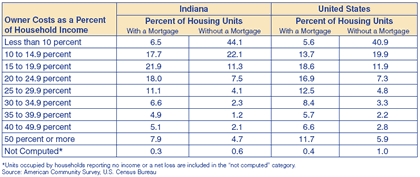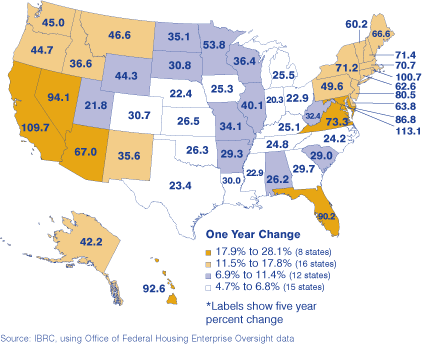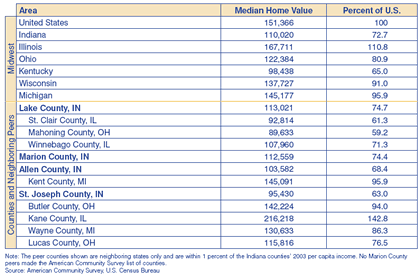Housing is Affordable in the Hoosier State
With all the new home construction occurring in the Indianapolis area, one might wonder about the costs associated with homeownership. New American Community Survey (ACS) data released by the U.S. Census Bureau sheds light on this subject. (1)
In 2004, 40 percent of Indiana’s occupied housing units with a mortgage paid 15 to 24.9 percent of their household income towards monthly homeownership costs.(2) Most experts feel a good rule of thumb is that no more than 30 percent of your income should go towards housing-related expenses; (3) many experts are even more conservative than that, claiming if a down payment of 10 percent is made, no more than 28 percent of household income should be used to pay the mortgage, property taxes and insurance. Indiana homeowners appear to have less difficulty in adhering to this principle than the rest of the nation, where 18 percent of mortgaged owners are paying out at least 40 percent of their household income to housing related expenses relative to Indiana’s 13 percent (see Table 1).
Table 1: Owner Costs as a Percent of Household Income, 2004
Indiana had 24.4 percent of its mortgaged owners spending 30 percent or more of their household income on selected monthly owner costs, ranking 44th and tying with Missouri.
In comparison, California (ranked first) and Nevada (ranked second) had 44.1 and 38.6 percent of its mortgaged owners paying out 30 percent or more of their household income towards homeownership-related expenses (see Figure 1). Of course, many parts of California and Nevada are experiencing what the media terms a “housing bubble” where their home appreciation rates may take care of the extra cost associated with homeownership. Figure 2 shows Nevada (ranked first) and California’s (ranked fourth) one-year home appreciation rates. Nevada’s housing stock increased in value by 28 percent and California’s increased by 25 percent, whereas Indiana had a 4.7 percent net increase—a full 8.7 percentage points below the nation. California, District of Columbia and Rhode Island home prices doubled over the five-year period. Longevity seems to be the key in the Indiana housing market where Indiana’s five-year appreciation rates were last in the nation but its 25-year rates earned the state a rank of 39.
Figure 1: Mortgaged Owners Spending 30 Percent or more of Household Income on Selected Monthly Owner Costs, 2004
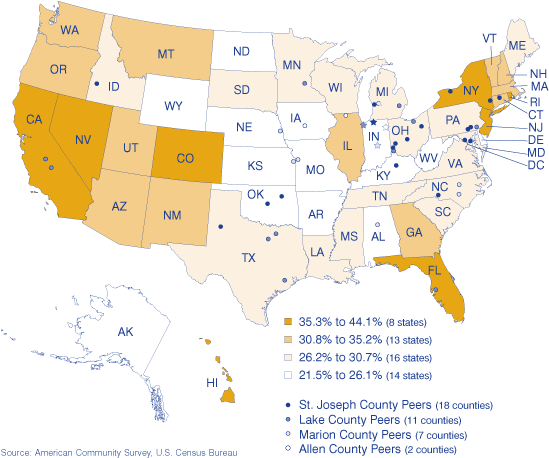
Figure 2: Percent Change in House Prices Through 2005:2
Similarly, renting is an affordable option in Indiana (ranked 44th) where only 37.8 percent of renting households spend 30 percent or more on rent and utilities.
In Indiana, four counties (Allen, Lake, Marion and St. Joseph) were sampled by the ACS to produce estimates. However, more counties were used to derive the state numbers. (4) Figure 1 shows the four counties and their peers across the nation in the percent of mortgaged owners spending 30 percent or more of their income on homeowner expenses, along with the state data. (5) Only seven states are more affordable. Meanwhile, 50 percent of renters in Florida and California spent 30 percent or more of their household income on rent and utilities each month.
The median monthly owner cost for those with a mortgage in Indiana was $963, an $11 increase from 2003. Indiana ranked 36th on this measure, and Hoosiers paid $884 dollars less than New Jersey residents, who had the highest monthly owner costs. Meanwhile, Hoosiers paid $194 more than West Virginians who ranked 51st.
Out of 236 counties or county equivalents across the nation, Lake ($1,034), Marion ($1,016), St. Joseph ($912) and Allen ($896) counties were ranked 196th, 199th, 227th and 231st, respectively for median monthly owner cost for those with a mortgage. Figure 3 shows the counties that are within 1 percent of the Indiana counties’ values. Comparatively, San Francisco had the highest median monthly housing cost ($2,472).
Figure 3: Median Monthly Housing Costs for Owner-Occupied Housing Units with a Mortgage, 2004
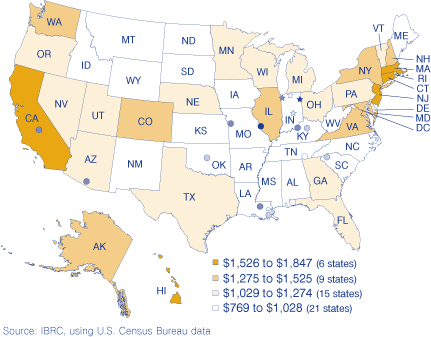

A typical Indiana resident paid $589 per month last year for rent and utilities, (6) $105 less than the U.S. average. In comparison, California renters paid $914 per month, which was only $49 less than what the typical Hoosier homeowner would pay in mortgage and other related costs.
In 2004, 71.8 percent of occupied housing units were owner-occupied, ranking the Hoosier state 12th in the nation. That is a 5.9 percentage point increase since Census 2000. Hawaii, California, New York and District of Columbia had the smallest percentage of owner-occupied housing. Of Indiana’s owner-occupied housing units, the median home value was $110,020, which was 72.7 percent of the U.S. value. Table 2 shows the median home values of Indiana’s neighboring states, along with Midwestern peer counties (within 1 percent of the Indiana counties’ 2003 per capita income).
Table 2: Indiana's Neighboring States Median Home Value, 2004
The old saying, “just because you can afford it doesn’t mean you should buy it,” probably applies here too. Hoosiers need to make sure they have all of their finances and debt in line before taking on one of life’s biggest debts.
Notes
- In 2010, the ACS is scheduled to replace the long-form census questionnaire that was administered to one in six addresses in Census 2000.
- Selected monthly owner costs are the sum of payments for mortgages, deeds of trust, contracts to purchase or similar debts on the property (including payments for the first mortgage, second mortgages, home equity loans and other junior mortgages); real estate taxes; fire, hazard and flood insurance on the property; utilities (electricity, gas, water and sewer); and fuels (oil, coal, kerosene, wood, etc.). It also includes, where appropriate, the monthly condominium fee for condominiums and mobile home costs (installment loan payments, personal property taxes, site rent, registration fees and license fees).
- The Department of Housing and Urban Development (HUD) has determined that no more than 30 percent of income should go toward housing costs.
- For a list of Indiana counties in the ACS sample, visit www2.census.gov/acs2004/.
- Peers were determined by being plus or minus 0.5 percentage points from the Indiana value.
- The data for monthly housing costs are developed from a distribution of selected monthly owner costs for owner-occupied units and gross rent for renter-occupied units. Gross rent includes aggregates of payments for contract rent and the cost of utilities and fuels.
Indiana Business Research Center, Kelley School of Business, Indiana University

